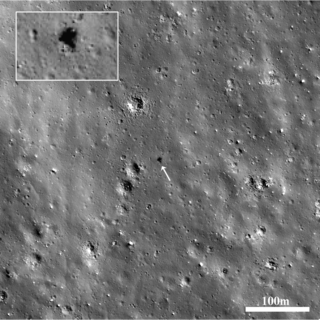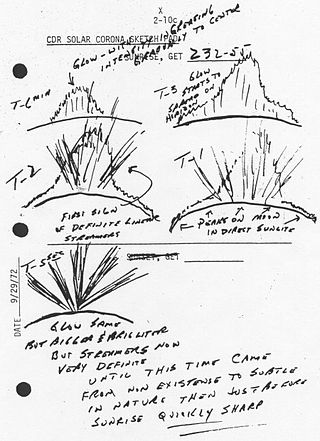
Apollo 12 was the sixth crewed flight in the United States Apollo program and the second to land on the Moon. It was launched on November 14, 1969, by NASA from the Kennedy Space Center, Florida. Commander Charles "Pete" Conrad and Lunar Module Pilot Alan L. Bean performed just over one day and seven hours of lunar surface activity while Command Module Pilot Richard F. Gordon remained in lunar orbit.

Apollo 14 was the eighth crewed mission in the United States Apollo program, the third to land on the Moon, and the first to land in the lunar highlands. It was the last of the "H missions", landings at specific sites of scientific interest on the Moon for two-day stays with two lunar extravehicular activities.

Apollo 16 was the tenth crewed mission in the United States Apollo space program, administered by NASA, and the fifth and penultimate to land on the Moon. It was the second of Apollo's "J missions", with an extended stay on the lunar surface, a focus on science, and the use of the Lunar Roving Vehicle (LRV). The landing and exploration were in the Descartes Highlands, a site chosen because some scientists expected it to be an area formed by volcanic action, though this proved not to be the case.

Apollo 17 was the eleventh and final mission of NASA's Apollo program, the sixth and most recent time humans have set foot on the Moon or traveled beyond low Earth orbit. Commander Gene Cernan and Lunar Module Pilot Harrison Schmitt walked on the Moon, while Command Module Pilot Ronald Evans orbited above. Schmitt was the only professional geologist to land on the Moon; he was selected in place of Joe Engle, as NASA had been under pressure to send a scientist to the Moon. The mission's heavy emphasis on science meant the inclusion of a number of new experiments, including a biological experiment containing five mice that was carried in the command module.

The Moon is Earth's only natural satellite. It orbits at an average distance of 384,400 km (238,900 mi), about 30 times Earth's diameter. The Moon always presents the same side to Earth, because gravitational pull has locked its rotation to the planet. This results in the lunar day of 29.5 Earth days matching the lunar month. The Moon's gravitational pull – and to a lesser extent the Sun's – are the main drivers of the tides.

Surveyor 7 was the seventh and last lunar lander of the American uncrewed Surveyor program sent to explore the surface of the Moon. A total of 21,091 pictures were transmitted to Earth.

A micrometeoroid is a tiny meteoroid: a small particle of rock in space, usually weighing less than a gram. A micrometeorite is such a particle that survives passage through Earth's atmosphere and reaches Earth's surface.

Regolith is a blanket of unconsolidated, loose, heterogeneous superficial deposits covering solid rock. It includes dust, broken rocks, and other related materials and is present on Earth, the Moon, Mars, some asteroids, and other terrestrial planets and moons.
The Lunar Precursor Robotic Program (LPRP) is a NASA program that uses robotic spacecraft to prepare for future crewed missions to the Moon. The program gathers data such as lunar radiation, surface imaging, areas of scientific interest, temperature and lighting conditions, and potential resource identification.

During the 1971 Apollo 15 mission to the Moon, and its three days of exploration on the lunar surface by David Scott and James Irwin, Command Module Pilot (CMP) Al Worden had a busy schedule of observations. Apollo 15 was the first mission to carry the Scientific Instrument Module (SIM) bay, which contained a panoramic camera, gamma ray spectrometer, mapping camera, laser altimeter and mass spectrometer. Worden had to operate the shutter and lenses on the cameras and turn on and off the various instruments. During the coast back to Earth, he would perform an EVA to retrieve film cassettes from the cameras.

Lunar soil is the fine fraction of lunar regolith found on the surface of the Moon and contributes to the Moon's tenuous atmosphere. Lunar soil differs in its origin and properties significantly from terrestrial soil.

The magnetic field of the Moon is very weak in comparison to that of the Earth; the major difference is the Moon does not have a dipolar magnetic field currently, so that the magnetization present is varied and its origin is almost entirely crustal in location; so it's difficult to compare as a percentage to Earth. But, one experiment discovered that lunar rocks formed 1 - 2.5 billion years ago were created in a field of about 5 microtesla (μT), compared to present day Earth's 50 μT. During the Apollo program several magnetic field strength readings were taken with readings ranging from a low of 6γ (6nT) at the Apollo 15 site to a maximum of 313γ (0.31μT) at the Apollo 16 site, note these readings were recorded in gammas(γ) a now outdated unit of magnetic flux density equivalent to 1nT.

The atmosphere of the Moon is a very scant presence of gases surrounding the Moon. For most practical purposes, the Moon is considered to be surrounded by vacuum. The elevated presence of atomic and molecular particles in its vicinity compared to interplanetary medium, referred to as "lunar atmosphere" for scientific objectives, is negligible in comparison with the gaseous envelopes surrounding Earth and most planets of the Solar System. The pressure of this small mass is around 3×10−15 atm (0.3 nPa), varying throughout the day, and in total mass less than 10 metric tonnes. Otherwise, the Moon is considered not to have an atmosphere because it cannot absorb measurable quantities of radiation, does not appear layered or self-circulating, and requires constant replenishment due to the high rate at which its gases are lost into space.

Third-party evidence for Apollo Moon landings is evidence, or analysis of evidence, about the Moon landings that does not come from either NASA or the U.S. government, or the Apollo Moon landing hoax theorists. This evidence provides independent confirmation of NASA's account of the six Apollo program Moon missions flown between 1969 and 1972.

The Lunar Atmosphere and Dust Environment Explorer was a NASA lunar exploration and technology demonstration mission. It was launched on a Minotaur V rocket from the Mid-Atlantic Regional Spaceport on September 7, 2013. During its seven-month mission, LADEE orbited the Moon's equator, using its instruments to study the lunar exosphere and dust in the Moon's vicinity. Instruments included a dust detector, neutral mass spectrometer, and ultraviolet-visible spectrometer, as well as a technology demonstration consisting of a laser communications terminal. The mission ended on April 18, 2014, when the spacecraft's controllers intentionally crashed LADEE into the far side of the Moon, which, later, was determined to be near the eastern rim of Sundman V crater.

The Lunar Reconnaissance Orbiter (LRO) is a NASA robotic spacecraft currently orbiting the Moon in an eccentric polar mapping orbit. Data collected by LRO have been described as essential for planning NASA's future human and robotic missions to the Moon. Its detailed mapping program is identifying safe landing sites, locating potential resources on the Moon, characterizing the radiation environment, and demonstrating new technologies.

Lunar swirls are enigmatic features found across the Moon's surface, which are characterized by having a high albedo, appearing optically immature, and (often) having a sinuous shape. Their curvilinear shape is often accentuated by low albedo regions that wind between the bright swirls. They appear to overlay the lunar surface, superposed on craters and ejecta deposits, but impart no observable topography. Swirls have been identified on the lunar maria and on highlands - they are not associated with a specific lithologic composition. Swirls on the maria are characterized by strong albedo contrasts and complex, sinuous morphology, whereas those on highland terrain appear less prominent and exhibit simpler shapes, such as single loops or diffuse bright spots.

Space dust measurement refers to the study of small particles of extraterrestrial material, known as micrometeoroids or interplanetary dust particles (IDPs), that are present in the Solar System. These particles are typically of micrometer to sub-millimeter size and are composed of a variety of materials including silicates, metals, and carbon compounds. The study of space dust is important as it provides insight into the composition and evolution of the Solar System, as well as the potential hazards posed by these particles to spacecraft and other space-borne assets. The measurement of space dust requires the use of advanced scientific techniques such as secondary ion mass spectrometry (SIMS), optical and atomic force microscopy (AFM), and laser-induced breakdown spectroscopy (LIBS) to accurately characterize the physical and chemical properties of these particles.
Dust ponds are a phenomenon where pockets of dust are seen in celestial bodies without a significant atmosphere, like asteroids, comets and some minor planets. These are smooth deposits of dust accumulated in depressions on the surface of the body, contrasting from the rocky terrain around them. They typically have different color and albedo compared to the surrounding areas. As there are no air around them, their method of formation is still debated. The phenomenon was discovered on 2000 October 28, by the spaceprobe NEAR Shoemaker on Asteroid 433 Eros.

The Lunar Ejecta And Meteorites experiment, also known as the LEAM experiment, was a lunar science experiment that flew on board Apollo 17's 1972 mission to the Moon. The goal of the experiment was to collect information on dust particles produced as a result of meteoroid impacts on the surface of the Moon.




















